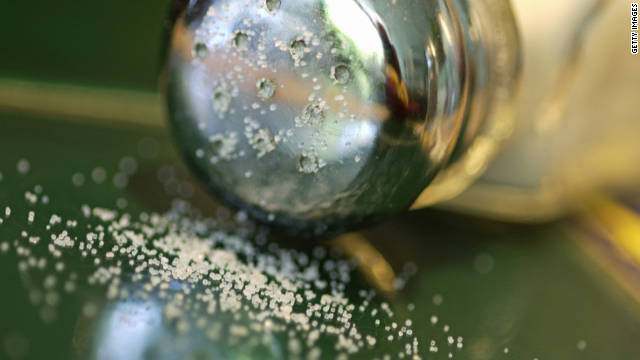FDA Reduces Sodium Guidelines in Food, Is It Enough?
0:50
(CNN) -
I never add salt to my food at home or in restaurants.
I also don't add salt to any recipe while cooking.
I am well aware of the link between salt, high blood pressure, and heart disease, which is the leading cause of death for American men and women.
However, I continue to exceed the recommended daily limit of 2,300 milligrams of sodium when eating out or adding processed or prepared ingredients to the meals I do.
Take salad dressing for example.
"I found salad dressings where a single serving (2 tablespoons) had more than 23% of the daily value for sodium," said Dr. Stephen Juraschek, an assistant professor at Harvard Medical School who researches sodium and hypertension.
DASH Diet and Exercise Help Manage Uncontrolled High Blood Pressure, Study Finds
"Most of my patients don't add salt to the table, but they don't realize that muffins, canned vegetables, and chicken breasts are among the worst culprits in America," he said.
Chicken breasts?
Yes, because in the manufacturing process, salt is added to the breasts to add volume and make them look bigger and more appetizing.
In fact, our diets contain hidden sources of sodium everywhere, said Dr. Janet Woodcock, acting commissioner of the US Food and Drug Administration (FDA), at a news conference. .
advertising
"Who would think of bread? And yet, bread is one of the highest sources of sodium that people get," Woodcock said.
"The problem is so cumulative: the tomato sauce, the peas, the bread, the salad dressing. Very soon, all the food has hidden salt in it, and right now it's very difficult for people to handle that on their own."
In fact, more than 70% of the sodium Americans consume comes from what the food industry has added to products that are later purchased in stores or restaurants, according to the FDA.
Will the price of tacos go up in Mexico?
3:09
Establishment of voluntary guides
Woodcock and his FDA team announced Wednesday that they want to help people control their salt intake by asking the food industry to voluntarily reduce sodium levels in 163 categories of the most consumed processed, packaged and prepared foods.
"The goals seek to decrease the average sodium intake from approximately 3,400 milligrams (mg) to 3,000 mg per day, approximately a 12% reduction, over the next 2.5 years," the FDA said in a statement announcing the final guidance.
Too Much Southern Food Can Cause Sudden Heart Attack, But The Mediterranean Diet Lowers Your Risk
However, five years ago, the agency issued preliminary guidance that set a much lower level: 2,300 milligrams, or about 1 teaspoon of table salt.
That's the recommended daily limit set by federal nutritional guidelines and the American Heart Association (AHA).
People at high risk for hypertension should aim for 1,500 milligrams.
Despite applauding the FDA's action as a "step forward," the AHA said the 3,000 mg / day target set for manufacturers was not low enough.
"Further reducing sodium to 2,300 mg could prevent approximately 450,000 cases of cardiovascular disease, gain 2 million quality-adjusted life years, and save approximately $ 40 billion in healthcare costs over a 20-year period," said the AHA in a statement.
Woodcock said the FDA set higher levels of 3,000 milligrams to help the public, and therefore manufacturers, stop preferring high-salt foods over time.
Why has food gotten more expensive in the US?
0:52
Experts doubt
It will work?
Experts who spoke to CNN were skeptical.
"The first problem is that this is voluntary. Food companies don't have to pay attention to it at all," said nutrition researcher Marion Nestlé, author of numerous books on food policy and marketing, including the 2019 book "Unsavory Truth. : How Food Companies Skew the Science of What We Eat ".
"It's not clear that the voluntary recommendations have been helpful," Juraschek said, pointing to a study he conducted showing that US consumption of salty foods has increased despite the 2016 FDA call to action for food manufacturers reduce sodium levels.
What is the healthiest fish to eat?
The best options for you and the planet
"I don't think the manufacturers I've talked to inherently like the idea of harming people, but when faced with the expense of discontinuing a product or changing industrial processes, I think a 'voluntary' mandate may not provide enough activation energy to make a difference, "he said.
"I would say that the change should not be delayed," he added.
"The FDA and government agencies need to be more aggressive in setting mandatory limits on salt in food and requiring more transparent warning labels."
Foods that can not be missing in the Mediterranean diet 1:02
Consumers need to help
Woodcock said that industry action will be monitored over the next several years and, if necessary, the agency could take additional action.
That's an important follow-up action, former CDC Director Dr. Tom Frieden told CNN in an email.
"Today's new guidance from the FDA is an important first step," said Frieden, who is president and CEO of Resolve to Save Lives, an initiative of Vital Strategies.
"But a first step is just that: a first step. It will be essential that the FDA monitor industry adherence to these voluntary guidelines, and if the industry does not take even these modest steps to reduce sodium, then they will be required mandatory warning labels and other actions, "wrote Frieden.
While acknowledging the difficulty in reading nutrition labels and understanding sodium levels in the foods they buy, Woodcock and his team repeatedly asked consumers to contribute to the effort to reduce salt in the American diet.
Mediterranean Diet May Prevent Memory Loss and Dementia, Study Finds
"We really trust that the public will be asking for these (low sodium foods) and being positive about them because that will help propel us toward a healthier food supply," said Susan Mayne, director of the Center for Food Safety and Applied Nutrition at the FDA.
Until government and manufacturer actions coincide to create products with less salt — and to make it easier to find salt in the foods we serve — there are actions people can take to reduce their dependence on salt.
The good news is that it doesn't actually take that long, just a few weeks, for a person's taste buds to adjust to eating less salt, Juraschek said.
One way to do this is to adopt the DASH diet, which stands for Dietary Approaches to Stop Hypertension.
It has been shown in studies to reduce high blood pressure, even in people with resistant hypertension (high blood pressure that cannot be controlled despite the use of three different medications).
The DASH eating plan includes four to six servings of vegetables and another four to six servings of fruit;
three servings of whole grain products;
two to four servings of skim or low-fat dairy products;
and several servings of lean meats and nuts, seeds, and legumes each day.
Against hypertension, the Dash diet and exercise 1:46
Here are more tips for reducing salt in your diet:
Check nutrition labels: In addition to salt, the label might use terms like monosodium glutamate (MSG, common in Chinese food), sodium citrate, sodium alginate, and sodium phosphate.
Familiarize yourself with common fonts.
Foods with the highest levels of salt include breads and rolls, pizza, sandwiches, deli meats and deli meats, soups, burritos and tacos, savory snacks like French fries, popcorn and crackers, chicken, cheese, and tortillas.
Stop using the salt shaker.
That helps, even if most of your sodium intake comes from processed foods.
Try seasoning without salt: "This strategy has been shown to reduce sodium intake," Juraschek said.
Ask for nutritional information at restaurants and try to avoid main dishes with excess sodium.
Avoid eating out and eat more minimally processed foods at home by eating more fresh and frozen fruits and vegetables
Remember, a daily goal for adults is just 1 teaspoon of salt or 2,300 milligrams.
For children under the age of 14, it's even less: 1,500 to 1,900 milligrams a day, or about a third of a teaspoon.









